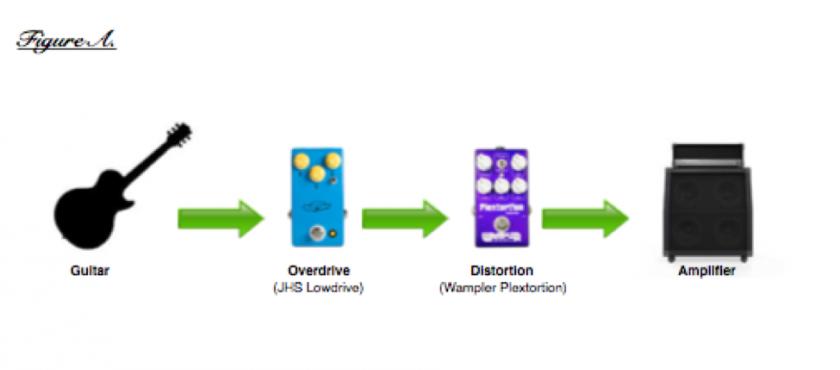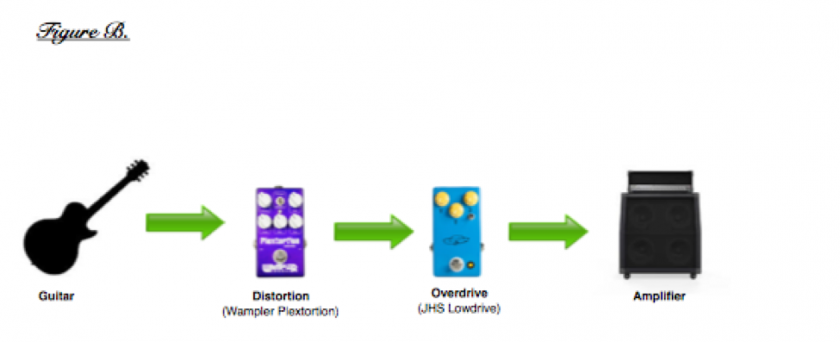
As guitar players, we are constantly searching for a unique sound: our player-unique tone that sets us apart from other guitarists. Even the most modest of gear heads is likely to have more than one overdrive, distortion, or both in their signal chain.
I’m going to discuss some dos and don’ts of using these pedals and give some input on my experiences using both simultaneously.
Firstly, when using these two, it’s important to understand in a practical sense what each pedal is doing to your signal. That doesn’t mean you need to be a physicist or audio engineer to understand what’s going on with your sound, but use your ears and experiment entirely with your pedal to see what it’s doing. The two biggest things to consider when using overdrive and distortion pedals are compression and gain.
It’s important to understand how compressed your signal is getting from your pedal because we have all been in a situation wherein we get on stage after spending months perfecting our tone, only to result in a vast difference between stage volume/tone and practice-room/bedroom volume/tone. Or, have you ever been at an open mic and heard someone performing, and even though their amp is seemingly loud and heavily distorted, you can’t make out a single note they are playing? Compression is almost always the culprit with an overly distorted tone.
Gain consideration is important because you need to make sure your pedals are all sending a balanced (equal-volumed) signal, OR at the signal balance that you want them at.
For example, I have a JHS Lowdrive (overdrive pedal), and a Wampler Plextortion (distortion pedal) that are my two main “gain/distortion” sounds I use on my pedal board. Without complicating my example, let’s just say for this conversation that my signal is: Guitar > JHS > Wampler > Amp (Figure A)

I have my JHS set so with my volume cranked on my guitar and playing full pick-strength, my clean volume and JHS-on volume are balanced with the stage volume I use my amp at. My Wampler-on is also balanced with my clean channel, but what is important about my signal chain is how much the Wampler compresses my channel compared to my JHS. Because of the compression, I can turn on my JHS and Wampler at the same time to increase the distortion, but with an insignificant change in gain (volume, decibels, however you would like to refer to it).
IF I had set up my JHS and Wampler in the following order: Guitar > Wampler > JHS > Amp (Figure B), it would be a lot more difficult for me to run both pedals at the same time without increasing my overall volume significantly. The reason is because now the JHS is increasing the gain of Wampler without the same compression the Wampler provides for the JHS.

This may seem a little wordy and complicated, but try it for yourself and make these mistakes at home! Even if you’re not interested in using both pedals at the same time, knowing this and setting your pedals up accordingly can help avoid embarrassing feedback squeals, or destroying a sound-guy’s ears/equipment by accidentally mis-pressing a pedal.
First, set up your pedals so when they are turned on, the volume is balanced with the clean channel. I would recommend that you do this with the amp set to a medium volume (if the amp is too quiet, it is essentially compressing the signal so you could have the pedal cranked and you wouldn’t even know the difference until you had to bring everything up to stage volume).
Try plugging in both pedals and turning everything on with one configuration, then the other. You’ll immediately notice that by putting the distortion pedal as the second pedal in the chain (or simply AFTER the overdrive pedal) that the tone created is much more manageable and without a significant volume boost. And trust me, if your volume is all over the place in an unmusical fashion, sound-guys don’t consider that to be “dynamic”. It’s just annoying.
Jordan Welbourne
